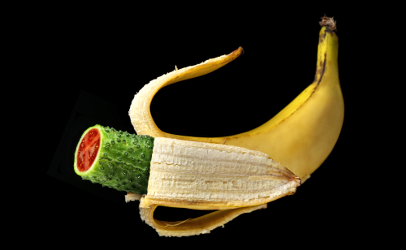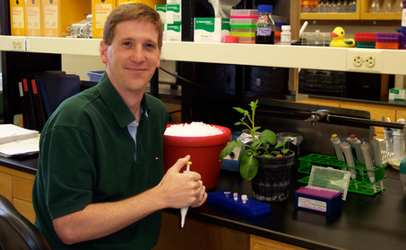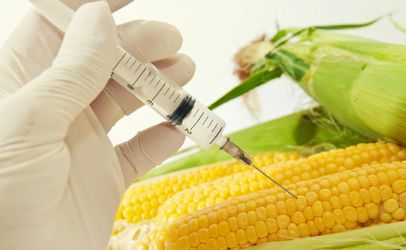Back in the late 1990s, I was a GMO virgin. I had never heard of GMOs — genetically modified organisms — nor had I ever had any contact with them, much less allowed any of them into my body.  But that was soon to change. I attended a workshop about a new advance in agriculture that could eliminate, or vastly reduce, the use of pesticides, while at the same time boost yields. How seductive can you get? As a journalist, I made haste toward the room where the talk was scheduled. At my side was my brother-in-law, a dahlia grower. He told me he didn’t think it applied to anything he did but that it did sound interesting — almost like science fiction. The presentation, which was part of an annual conference for farmers in Western Washington, focused on the wonders of a new type of potato dubbed the NewLeaf Potato. What set it apart from hybrid varieties was that it had been bred using genetic modification so it could resist the nasty Colorado potato beetle. Dennis Halterman, a research geneticist for the U.S. Department of Agriculture, recently explained how modifying the potato so it contains the Bt toxin — a protein that comes from a bacteria and is used in both organic production and biotech (GMO) crops — can help protect the plants from insects.
But that was soon to change. I attended a workshop about a new advance in agriculture that could eliminate, or vastly reduce, the use of pesticides, while at the same time boost yields. How seductive can you get? As a journalist, I made haste toward the room where the talk was scheduled. At my side was my brother-in-law, a dahlia grower. He told me he didn’t think it applied to anything he did but that it did sound interesting — almost like science fiction. The presentation, which was part of an annual conference for farmers in Western Washington, focused on the wonders of a new type of potato dubbed the NewLeaf Potato. What set it apart from hybrid varieties was that it had been bred using genetic modification so it could resist the nasty Colorado potato beetle. Dennis Halterman, a research geneticist for the U.S. Department of Agriculture, recently explained how modifying the potato so it contains the Bt toxin — a protein that comes from a bacteria and is used in both organic production and biotech (GMO) crops — can help protect the plants from insects. 
 Going one step further, crops such as corn and soybeans could be genetically engineered to resist glyphosate — think RoundUp herbicide from Monsanto. With genetic engineering the weeds would be killed but not the crops. Oh, and there was the “fish tomato,” which never did get past the research stage, but which, nevertheless, is still being used as an example of genetic engineering. In hopes of developing a tomato that could withstand colder temperatures, researchers came up with a tomato that contained an antifreeze gene from the winter flounder. After the presentation, still dazzled by what I had learned, I walked down the hall to the coffee break room. I immediately spotted some people I knew who worked for Cascadian Farm, an organic “giant,” which at that time had its headquarters in the same Western Washington county where I lived. Later General Mills bought it. Joyfully, I recounted what I had just heard. I was surprised at how dismally they reacted. Turns out, they told me, this wasn’t what I had thought. Rather it was a technology that had dire consequences, not only for agriculture, but also the environment and all of mankind. I duly noted what they said and included it in an article I wrote about the presentation. But it took up only a very small part of the article. Actually, I started it out by talking about “opening the door to an entirely new world of agriculture,” one that allowed crops to be bountifully grown without pesticides. And, yes, it was a “new world.” By 2014, a record 181.5 million hectares (1 hectare equals 2.47 acres) of biotech crops were grown globally, an increase of more than six million hectares from 2013, according to a report released by the International Service for the Acquisition of Agri-Biotech Applications (ISAAA). “The accumulated hectarage of biotech crops grown in 1996 to 2014 equals, roughly, 80 percent more than the total land mass of China,” said Clive James, ISAAA Founder and report author. “Global hectarage has increased more than 100-fold since the first plantings of biotech crops.” Costumes or facts? Several years later, I attended an international conference about biotechnology in Seattle. As I made my way to the building where it was being held, I had to walk through a large crowd of mostly young people dressed in all sorts of costumes. A tomato crossed with a fish, for example. There were all sorts of signs about the dangers of “Frankenfoods” aka GMOs. I sat on a bench and took it all in. And also took a lot of photos. These costumed protesters were definitely more interesting than a sober-faced scientist or researcher. At one point, one of the protesters took a seat next to me. He had just told the crowd that it was their duty to break into the labs and destroy the research and any experiments being conducted there. When I gently warned him that yes, we have the freedom of speech in this country, but that it’s tempered by the stipulation that it’s not to incite violence, he told me with all of the fervent idealism of a young person that he was willing to die to stop this new “very dangerous” science. When I went down the escalator into a room where the scientists and researchers were preparing for their presentations, I asked a woman who had just finished putting information into a computer if she had seen the protesters. “Yes,” she told me, with a very dismissive tone in her voice. “What do they know? We’re the scientists. We’re the ones with the facts.” Facts and fears As the years rolled on, I began to see the “facts” about biotechnology didn’t seem to be getting much play in the media — at least not compared to all of the articles featuring “fervent concerns” about it. Turns out that a lot of people didn’t want to buy food with GMOs in it. This included people who didn’t even know what a GMO was.
Going one step further, crops such as corn and soybeans could be genetically engineered to resist glyphosate — think RoundUp herbicide from Monsanto. With genetic engineering the weeds would be killed but not the crops. Oh, and there was the “fish tomato,” which never did get past the research stage, but which, nevertheless, is still being used as an example of genetic engineering. In hopes of developing a tomato that could withstand colder temperatures, researchers came up with a tomato that contained an antifreeze gene from the winter flounder. After the presentation, still dazzled by what I had learned, I walked down the hall to the coffee break room. I immediately spotted some people I knew who worked for Cascadian Farm, an organic “giant,” which at that time had its headquarters in the same Western Washington county where I lived. Later General Mills bought it. Joyfully, I recounted what I had just heard. I was surprised at how dismally they reacted. Turns out, they told me, this wasn’t what I had thought. Rather it was a technology that had dire consequences, not only for agriculture, but also the environment and all of mankind. I duly noted what they said and included it in an article I wrote about the presentation. But it took up only a very small part of the article. Actually, I started it out by talking about “opening the door to an entirely new world of agriculture,” one that allowed crops to be bountifully grown without pesticides. And, yes, it was a “new world.” By 2014, a record 181.5 million hectares (1 hectare equals 2.47 acres) of biotech crops were grown globally, an increase of more than six million hectares from 2013, according to a report released by the International Service for the Acquisition of Agri-Biotech Applications (ISAAA). “The accumulated hectarage of biotech crops grown in 1996 to 2014 equals, roughly, 80 percent more than the total land mass of China,” said Clive James, ISAAA Founder and report author. “Global hectarage has increased more than 100-fold since the first plantings of biotech crops.” Costumes or facts? Several years later, I attended an international conference about biotechnology in Seattle. As I made my way to the building where it was being held, I had to walk through a large crowd of mostly young people dressed in all sorts of costumes. A tomato crossed with a fish, for example. There were all sorts of signs about the dangers of “Frankenfoods” aka GMOs. I sat on a bench and took it all in. And also took a lot of photos. These costumed protesters were definitely more interesting than a sober-faced scientist or researcher. At one point, one of the protesters took a seat next to me. He had just told the crowd that it was their duty to break into the labs and destroy the research and any experiments being conducted there. When I gently warned him that yes, we have the freedom of speech in this country, but that it’s tempered by the stipulation that it’s not to incite violence, he told me with all of the fervent idealism of a young person that he was willing to die to stop this new “very dangerous” science. When I went down the escalator into a room where the scientists and researchers were preparing for their presentations, I asked a woman who had just finished putting information into a computer if she had seen the protesters. “Yes,” she told me, with a very dismissive tone in her voice. “What do they know? We’re the scientists. We’re the ones with the facts.” Facts and fears As the years rolled on, I began to see the “facts” about biotechnology didn’t seem to be getting much play in the media — at least not compared to all of the articles featuring “fervent concerns” about it. Turns out that a lot of people didn’t want to buy food with GMOs in it. This included people who didn’t even know what a GMO was.  That became clear to me one day when I was at a party and talking with a good friend. She clutched my arm, and, with a look of terror in her eyes, told me she had eaten GMOs in some corn chips without knowing it. What was going to happen to her she asked as she took a drag off the cigarette she was holding in her other hand. We all know the dangers of smoking — no secrets there. The packaging even tells us about them. When people consider GMOs, it’s a more basic fear than that. Or, as one academic paper out of the University of Hawaii-Manoa put it, “Many individuals, when confronted with conflicting and confusing statements about the effect of genetic engineering on our environment and food supply, experience a ‘dread fear’ that inspires great anxiety.” Then there was what many saw as the “dark side” to all of this. A power so powerful that it actually copyrighted the GMO crops, thus putting a stop to the time-honored farming tradition of saving seeds from one year’s crop to plant the next year. This “dark force” had a name, and it was Monsanto. Many opponents have grown to hate this huge international company more than the biotechnological advances it has spawned. They warn that the corporation is trying to own life itself. Welcome to my world
That became clear to me one day when I was at a party and talking with a good friend. She clutched my arm, and, with a look of terror in her eyes, told me she had eaten GMOs in some corn chips without knowing it. What was going to happen to her she asked as she took a drag off the cigarette she was holding in her other hand. We all know the dangers of smoking — no secrets there. The packaging even tells us about them. When people consider GMOs, it’s a more basic fear than that. Or, as one academic paper out of the University of Hawaii-Manoa put it, “Many individuals, when confronted with conflicting and confusing statements about the effect of genetic engineering on our environment and food supply, experience a ‘dread fear’ that inspires great anxiety.” Then there was what many saw as the “dark side” to all of this. A power so powerful that it actually copyrighted the GMO crops, thus putting a stop to the time-honored farming tradition of saving seeds from one year’s crop to plant the next year. This “dark force” had a name, and it was Monsanto. Many opponents have grown to hate this huge international company more than the biotechnological advances it has spawned. They warn that the corporation is trying to own life itself. Welcome to my world  Some years later I was very surprised indeed to learn that GMOs had entered my world — big time. Dairy farmers in my neck of the woods were growing biotech corn. As I drove by acres and acres of it, I couldn’t help but marvel at how well it was growing — how strangely beautiful it looked. My article about it shocked readers. I discovered this when I went to the local farmers market and everyone was abuzz about it. “How could they be doing this here?” the farmers and the market shoppers were saying to each other. “Someone should report them for doing it.” Well, of course, it was all perfectly legal. In fact, the Food and Drug Administration does not require any special labeling for food made with plants bred by genetic engineering. The agency says there is no nutritional difference between GMO crops and those grown with non-GMO seed. Try telling that to the consumers who see things otherwise. Many point to this as a food safety issue because even though no confirmed cases of actual health problems caused by eating GMO foods have been documented. That doesn’t mean none will, they say. Why should people be used as guinea pigs, they ask. No let-up in labeling battle Recently activists and industry reps sat down twice with none other than Secretary of Agriculture Tom Vilsack to see if they could come up with a compromise about labeling food processed with genetic engineering. No compromise could be found, and no one is placing any bets on whether there will be a third meeting. On the legal front, the two sides — activists and “big ag” — will continue the battle in federal court, in Congress and state-by-state. As for the voters, they rejected mandatory GMO labeling in four Western states — among them heavyweights California and Washington. In Congress, the House and Senate appear split over whether such labeling should be a state or federal issue. Retailers and food companies are paying attention. In 2013, for example, Whole Foods announced that by 2018, all products in its U.S. and Canadian stores must be labeled if they contain genetically modified organisms. As such, it was the first national grocery store to set a deadline for GMO labeling.
Some years later I was very surprised indeed to learn that GMOs had entered my world — big time. Dairy farmers in my neck of the woods were growing biotech corn. As I drove by acres and acres of it, I couldn’t help but marvel at how well it was growing — how strangely beautiful it looked. My article about it shocked readers. I discovered this when I went to the local farmers market and everyone was abuzz about it. “How could they be doing this here?” the farmers and the market shoppers were saying to each other. “Someone should report them for doing it.” Well, of course, it was all perfectly legal. In fact, the Food and Drug Administration does not require any special labeling for food made with plants bred by genetic engineering. The agency says there is no nutritional difference between GMO crops and those grown with non-GMO seed. Try telling that to the consumers who see things otherwise. Many point to this as a food safety issue because even though no confirmed cases of actual health problems caused by eating GMO foods have been documented. That doesn’t mean none will, they say. Why should people be used as guinea pigs, they ask. No let-up in labeling battle Recently activists and industry reps sat down twice with none other than Secretary of Agriculture Tom Vilsack to see if they could come up with a compromise about labeling food processed with genetic engineering. No compromise could be found, and no one is placing any bets on whether there will be a third meeting. On the legal front, the two sides — activists and “big ag” — will continue the battle in federal court, in Congress and state-by-state. As for the voters, they rejected mandatory GMO labeling in four Western states — among them heavyweights California and Washington. In Congress, the House and Senate appear split over whether such labeling should be a state or federal issue. Retailers and food companies are paying attention. In 2013, for example, Whole Foods announced that by 2018, all products in its U.S. and Canadian stores must be labeled if they contain genetically modified organisms. As such, it was the first national grocery store to set a deadline for GMO labeling.  Last month, the Campbell Soup Co. came out with this surprising news: It will advocate for federal legislation that would require all foods and beverages regulated by the FDA and the USDA “to be clearly and simply labeled for GMOs.” It will also withdraw from all efforts led by coalitions and groups opposing such measures. While the company’s officials say they’re optimistic that a federal solution can be found in a reasonable amount of time, they are prepared to label all of Campbell’s U.S products for the presence of GMOs regardless whether government mandates it. At the same time, the company says it continues to recognize that “GMOs are safe, as the science indicates that foods derived from crops using genetically modified seeds are not nutritionally different from other foods.” The company has a list of GMO ingredients on its website. The company’s press release also points to the marketplace for the reason it has switched sides: “With 92 percent of Americans supporting the labeling of GMO foods, Campbell believes now is the time for the federal government to act quickly to implement a federal solution.” Campbell is a good example of how food companies have changed the way they talk about their products to consumers. “Real food that matters for life’s moments” is how the company describes its purpose. “For generations, people have trusted Campbell to provide authentic flavorful and readily available foods and beverages that connect them to each other, to warm memories, and to what’s important today,” says the company. Sounds a lot like a foodie love-in, doesn’t it?
Last month, the Campbell Soup Co. came out with this surprising news: It will advocate for federal legislation that would require all foods and beverages regulated by the FDA and the USDA “to be clearly and simply labeled for GMOs.” It will also withdraw from all efforts led by coalitions and groups opposing such measures. While the company’s officials say they’re optimistic that a federal solution can be found in a reasonable amount of time, they are prepared to label all of Campbell’s U.S products for the presence of GMOs regardless whether government mandates it. At the same time, the company says it continues to recognize that “GMOs are safe, as the science indicates that foods derived from crops using genetically modified seeds are not nutritionally different from other foods.” The company has a list of GMO ingredients on its website. The company’s press release also points to the marketplace for the reason it has switched sides: “With 92 percent of Americans supporting the labeling of GMO foods, Campbell believes now is the time for the federal government to act quickly to implement a federal solution.” Campbell is a good example of how food companies have changed the way they talk about their products to consumers. “Real food that matters for life’s moments” is how the company describes its purpose. “For generations, people have trusted Campbell to provide authentic flavorful and readily available foods and beverages that connect them to each other, to warm memories, and to what’s important today,” says the company. Sounds a lot like a foodie love-in, doesn’t it? 
Sponsored by Marler Clark
